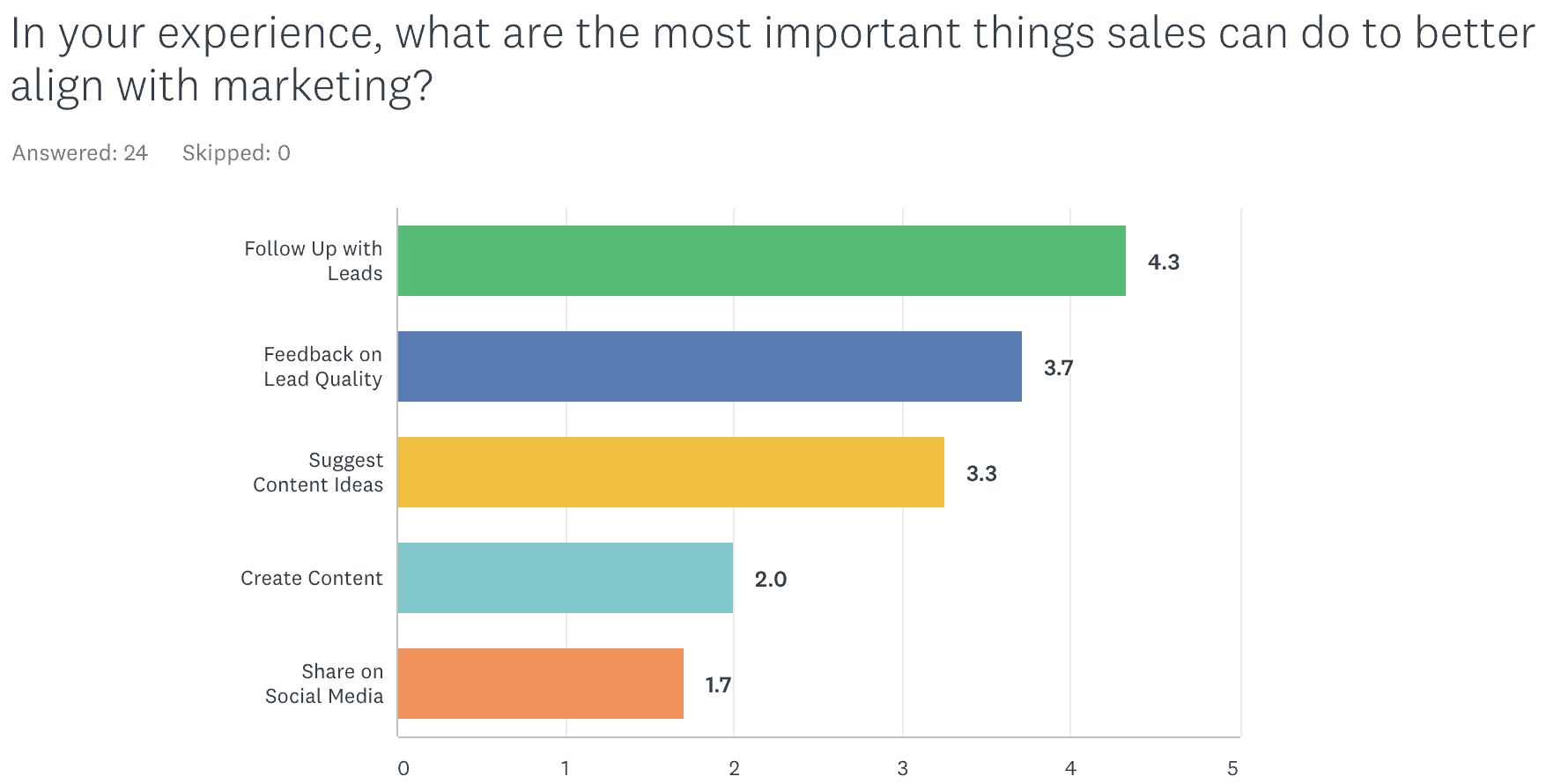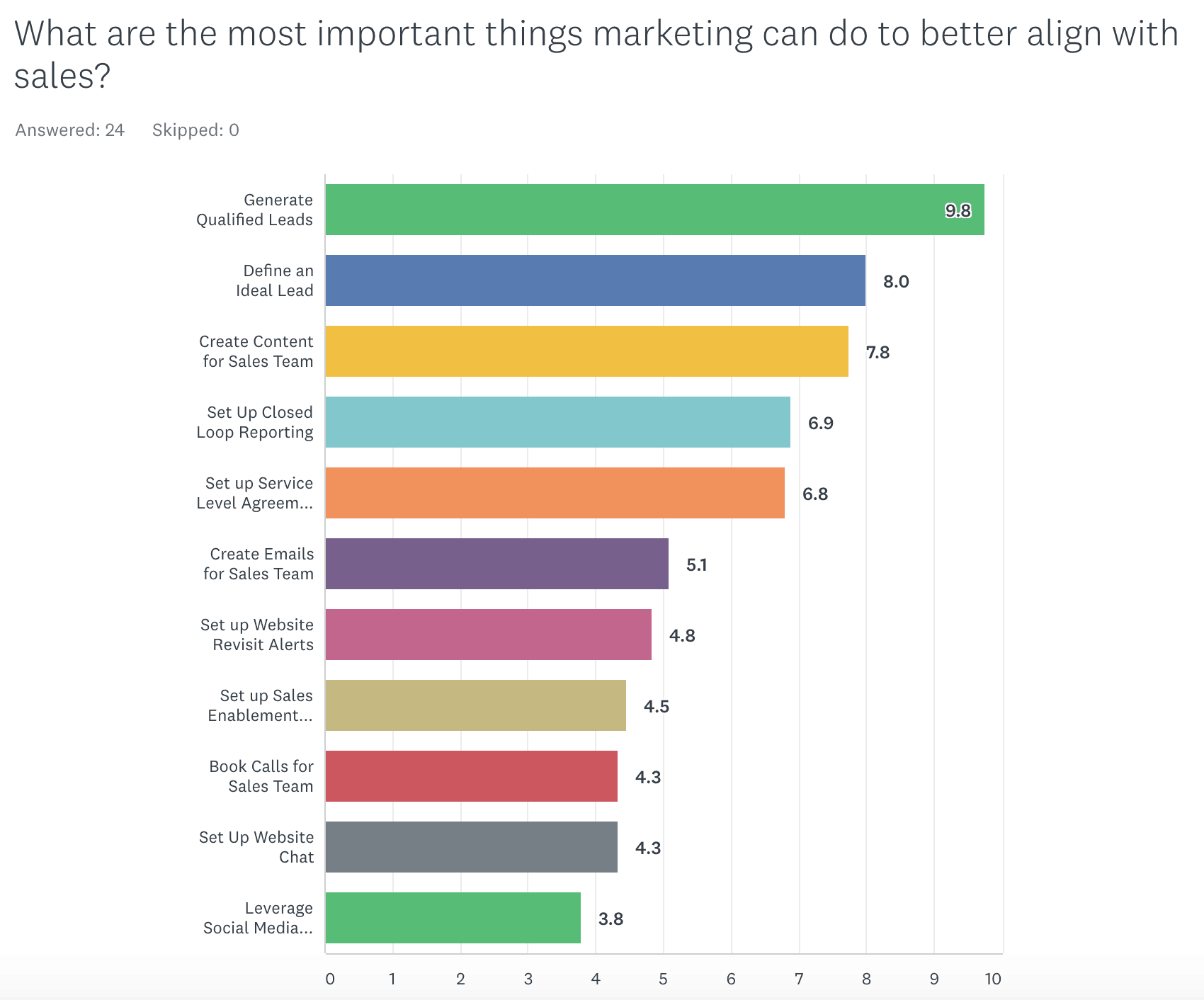Table of contents
In HubSpot’s State of Inbound 2017 report, 6000 respondents were polled on the current state of alignment between marketing and sales teams.
As you can see in the graph below, there seems to be significant disagreement on whether companies are successfully connecting two teams.

While 31% of C-level executives feel that their marketing and sales teams are tightly aligned, only 17% of managers and individual contributors feel the same way. And, considering those are the employees that need to deal with alignment on a daily basis, executives may be overrating the effectiveness of communication within their organization.
So, we polled our community of inbound marketers to learn what specific tactics will guarantee that sales and marketing are on the same page. If you are not using any of these tactics at your own company, the goals of the two teams are probably not as aligned as you think they are.
By employing some of these tips, you have a great opportunity to get more revenue out of your existing team, and make everyone’s lives a little easier along the way. Here are a few tactics that will help.
Sales-Marketing Alignment Tactics
- Better Use of Technology
- Collaborative Content Creation
- Scheduled Time for Meetings
- Shared Goals
- Using The Buyer’s Journey

Better Use of Technology
It’s one thing to have sales and marketing sit in a meeting together and agree on the best way to hand off leads. But it is a whole separate challenge to make the handoff within the software you use. If your marketing automation system and CRM originate from the same software provider, like HubSpot, your life gets a little easier.
But, you still need to set up automation workflows and emails at the right time. The new flood of information should be helpful rather than overwhelming.
 Kayli Kunkel
Kayli Kunkel
Ironpaper
Tactic: Get the right tools in place. The less friction you can place on the sales team, the more likely they will be to engage. We prefer the combination of HubSpot Marketing CRM and the HubSpot Sales platform, and we work early and collaboratively to train sales teams in using Sequences, creating HubSpot deal stages, and attaching content that is relevant to inbound leads.

 Jen Spencer
Jen Spencer
SmartBug Media
Tactic: Even though I believed I was sharing all marketing activities with the sales team — we were all part of the same department, in fact — with so much information flowing regularly, it was overwhelming for the SDRs to prioritize what I shared with them.
One very simple adjustment we made was that when we planned to launch a new premium asset (ebook, checklist, guide, etc), the SDR team blocked out 30-40 minutes on their calendars at the time of launch. Using HubSpot’s sales enablement tools, the SDRs could watch their prospects engage with the content in real-time. They placed calls to their sales-ready prospects and were able to improve their connection and meeting booking rates because of their timing.
 Parker Short
Parker Short
Jaxzen Marketing Strategies
Tactic: We set up a lead handoff workflow in HubSpot every time, whether they use HubSpot as a CRM or not. We also spend a fair amount of time customizing the lead assignment notification email to make sure that it’s very actionable. Salespeople don’t want a ton of extra emails, so we focus on surfacing what’s the most important about that lead when they’re handed off.
We’ll combine this with some recommended next steps and some content to share if it’s applicable. Then we make sure that a task is created and it’s clear that the ball is now in their court. This is a lot better outcome than hoping people see a new lead within the CRM or in a queue. The result is that it’s 100% clear when the handoff happens and what the expectations are.
If you use HubSpot, you can track your entire pipeline in one place for free using the Pipeline Performance dashboard.


Collaborative Content Creation
Rather than give a lecture to your sales team on the merits of your inbound marketing investments, you can instead demonstrate its value by getting members of the sales and marketing team to work on a content project together.
By creating landing pages or bottom-of-funnel content together, marketers and salespeople can learn more about the challenges their prospects face, and deliver a quick win for the two teams.
 Jeff Coon
Jeff Coon
Stream Creative
Tactic: We help companies create interactive and personalized sales pages. The marketing team knows how powerful their website can be in the sales process, and the sales team understands and lives in the world of proposals.
By getting sales and marketing together to map out a strategy on how, when and where to use these interactive sales pages, it fosters great discussion around a concept that both teams are familiar with (a proposal.)
In order to use these sales pages effectively, sales and marketing have to determine which prospects get this level of customization, which naturally leads to discussions about:
- Buyer personas,
- Lead scoring,
- Creating personalized videos,
- Email follow-up,
- Tracking and analytics, etc.
We’ve found that this tangible asset (the sales page) creates a sense of focus and clarity around a common goal — as opposed to discussing the value of inbound sales, content marketing, etc. We seem to lose sales people when we discuss those topics.
But when we talk about giving them a competitive advantage and building trust and a personal connection with their prospects, they are definitely more attentive.
You can read the full background on Stream Creative’s method here.
 James Carbary
James Carbary
Sweet Fish Media
Tactic: We use our podcast to align sales and marketing. The sales team determines the guests that we feature in each episode of the podcast (we interview decision makers at our target accounts).
Marketing handles the logistics of the interview as well as the promotion. Once the interview is complete, the decision-maker at our target account has a tangible relationship with our brand (great for sales) and Marketing gets excellent content that they can repurpose in a million different ways.
 Michael Rand
Michael Rand
Market Veep
Tactic: Getting our clients involved in producing content is extremely important for aligning our efforts with that of our clients’ sales teams. We recognize that they know their buyers much better than we do and they have first-hand insight into their industry.
Their knowledge is indispensable for us when creating content. In return, their sales team knows what their leads are reading and that what they are reading reflects what they’ll hear from salespeople.
During the client onboarding process, we hold two separate conference calls that are solely dedicated to creating buyer personas and generating a content plan. The buyer persona segment is the most important part. If we’re going to be writing content for then, we need to know who that content is intended for.
In the content call, we gather topic sand subtopics that they know their buyers are searching for online. These form the basis for our blog posts, content offers, and pillar pages. Once we have a base of topics, we’ll either suggest topics for content in the months moving forward or ask the client for additional topics.
We have an approval process for all the content we produce. We don’t publish it until our point of contact (usually a salesperson) signs off on it.
 Brittany Laeger
Brittany Laeger
StoryTeller Media + Communications
Tactic: Content is one of the most under-utilized tools to improve sales and marketing alignment. Content can be an immensely useful and non-invasive way for salespeople to reach out to prospects and potential customers.
The sales team should be one of marketing’s biggest assets when it comes to creating content that will help bring people closer to a purchasing decision. Start by answering the most common questions that your sales team answers and help them build up an arsenal of great content they can use in the sales process.

Scheduled Time for Meetings
Although marketers and salespeople may aspire to build their relationship “one day,” you can accelerate the process by setting up a weekly meeting, even if it unstructured to begin with…
 Mike Schutz
Mike Schutz
RAIN Group
Tactic: Marketing and sales leadership should spend shared, unstructured time together. An hour meeting with no agenda except to ‘talk strategy’ or have lunch. They should ask each other questions about their goals, philosophies, and initiatives.
Nothing is better than spending time together for gaining understanding and building trust, two critical preconditions of marketing and sales alignment.
 Evan Ebert
Evan Ebert
Fannit
Tactic: Having a weekly or bi-weekly comprehensive meeting between marketing and sales is important.
However, you also need to have somebody in the organization who can ask the right questions and run the meeting. Most companies and teams have very insightful contributors…but not everybody is willing to step up to the plate and share, unless prompted.
One option is to grouse about it and say, “Well, we just need a team that can speak their minds!”
The other option is to face the reality that not everybody on a given team is going to possess the same set of strengths. Some individuals have more of a proclivity to speaking their minds in meetings, even when not prompted.
Others may still have something valuable to say, if they’re asked or given a comfortable medium to do it in.
So make sure that you have somebody running your sales & marketing meetings who is…
1. Good at keeping order
2. Effective at communicating with all personality types
3. Can bring out the best in each teammate
Get all the best perspectives you possibly can, and use the right people to bring those perspectives to the table!
 Rob Steffens
Rob Steffens
Bluleadz
Tactic: Instead of having 2 separate weekly Sales and Marketing meetings, we have combined them. We have 1 weekly “Smarketing” meeting. From there, we are constantly able to walk away with new ideas.
After one of these meetings, both sides agreed to have marketing sit in silently on some sales calls. This gave the marketing team a better understanding of their personas and their current pains/questions. We were able to create content around those questions, so these specific customer personas have the information they desire at their fingertips.
 Omi Diaz-Cooper
Omi Diaz-Cooper
Diaz & Cooper Advertising
Tactic: We’ve found that companies where sales and marketing meet regularly, share complementary goals and share the same promotional content do a much better job of aligning their efforts. Everyone is rowing in the same direction!
 Paulo Henrique Lemos
Paulo Henrique Lemos
Hook Digital
Tactic: Build an integrated marketing and sales funnel and have both teams agree on the stages, the metrics and the actions that each one is responsible for. Then spend at least 20-30 minutes every week reviewing progress and making decisions about where and how to improve each metric.
 Tim Stobierski
Tim Stobierski
Pepperland Marketing
Tactic: Sales and Marketing alignment is all about making sure that everyone is on the same page and working towards the same goals: Increasing closures and boosting revenue.
One of the simplest ways to achieve this is to have joint sales and marketing meetings periodically to make sure that everyone is aligned.
At a bare minimum, these meetings should take place quarterly. But a whole quarter is a long time to go between alignments. Ideally, these would happen monthly or, better yet, weekly. The more frequent the contact, the less you’ll have to realign if things get off track, and the more effective your time can be spent.
But it’s important that you use that time wisely. Don’t talk about what your tactics that worked. Talk about what went off the rails, so that everyone in the room can contribute their ideas and figure out how to get everything back on track.
For example, if sales are down, what’s the cause? If it’s because the quality of the leads has gone down, then Marketing knows that it needs to make some changes. If it’s because Sales didn’t log enough calls, then they know to pick up the pace on their end. Etc.
 Eric Quanstrom
Eric Quanstrom
CIENCE Technologies
Tactic: Have the marketing team members present as observers in the different part of the sales process on at least a quarterly basis. This can include Discovery calls, Demo’s, Negotiations, or other defined steps in the sales process. The benefit here is firsthand knowledge.

Shared Goals
If marketing is evaluated on traffic and leads generated, while the sales team is evaluated on the number of deals closed and revenue generation, then you shouldn’t be surprised when the two sides never talk!
There must be some sort of shared goal in order to encourage collaboration.
 Nicole Mertes
Nicole Mertes
Weidert Group
Tactic: Set up a Service Level Agreement (SLA) between Sales and Marketing. Alignment starts with a discussion on the role each department plays to reach the common goal.
 Greg Linnemanstons
Greg Linnemanstons
Weidert Group
Tactic: Transparency and visibility around goals, expectations, and results between marketing and sales, to build a 360-degree culture of accountability. Those things that you measure with your marketing dashboard, and report on get attention, from lead attraction to client retention measures.
 Sara Larsen
Sara Larsen
Doidea
Tactic: Unite around joint KPIs. The only way to ensure both departments strive towards the same end goal, is to share the same end goal.
 Kade Wilcox
Kade Wilcox
Primitive Social
Tactic: At Primitive Social, our main goal for alignment is establishing a designated growth team that would bridge the gap between sales and marketing, allowing us to be effective and efficient in meeting the overall company goals. This team, though primarily remote, holds weekly meetings using video conferencing to increase communication and trust. We build specific, attainable, and measurable goals that everyone is working towards together vs. working in silos.
 Chris Handy
Chris Handy
ClosedWon
Tactic: Start with a list of target accounts and discuss how you plan to reach them as a group.
The best way for two parties to end up in the same place at the end is to start the journey together. Yet most company cultures default to marketing and sales having starting lines that aren’t in the same ballpark. When we work with clients, we start by implementing a list of target accounts to pursue. This then dictates the strategy for the entire team. Suddenly the sales team will actually share content on social media when they understand the content was written for their target account. Suddenly, everything starts to become more clear and the tools you use, like live messaging, start to get cross-company adoption when marketing knows the leads that sales wants to chat with.
Track SMART goals for your entire team in one place with Databox’s SMART goals tool.


Use The Buyer’s Journey
After your sales and marketing teams start talking about the concerns and challenges commonly shared by prospects, a number of opportunities open up.
First, salespeople can advise whether the top of funnel content really addresses the challenges of the ideal buyer persona.
Second, marketers can learn about bottom-of-funnel content opportunities that will help salespeople accelerate the sales process.
 Dani Buckley
Dani Buckley
LeadG2
Tactic: Create shared target persona profiles, ideal customer profiles, and lead definitions so that both marketing and sales team members know exactly who they’re targeting and understand how to properly communicate and reach them.
 Trevor van Rensburg
Trevor van Rensburg
Spitfire Inbound
Tactic: We’ve implemented a unified, negotiated definition of MQLs and SQLs. This shortens the time between lead generation and closing deals. If marketing and sales don’t communicate about what a quality lead looks like, it becomes impossible for marketers to attract the right leads for the sales team.
Browse through these free sales leads dashboard here.
 Chris Fell
Chris Fell
g2m Solutions
Tactic: Don’t align around your internal definitions of your funnel stages like MQL, or prospect, but instead align on the buyer’s or customer’s decision stages. For example, interest expressed, needs agreed, preference formed, decision made and so on.
Honor the buyer’s thinking process, not your selling process. Build your data model and KPIs around these customer definitions and you will be aligned.
Survey of Top Priorities for Sales and Marketing
The experts suggested (at least) 10 different tactics you can try to create a bigger connection between marketing and sales. So, we asked them which ones should be the highest priority.

The best way for sales to work with marketing is to follow up with the leads that marketing has captured.
Okay, that one isn’t too much of a surprise. But, the second most popular suggestion, feedback on lead quality, at least shows that each team should take some ownership of lead quality. Salespeople are accustomed to complaining about poor quality leads from marketing, and marketers complain that salespeople never call their leads. Having regular conversations about lead quality, though, is a more constructive way of resolving this dispute.
We also asked respondents to tell us which marketing tactics are most critical for sales alignment…

Again, the top priority by consensus was generating qualified leads. But the second most popular tactic was “defining an ideal lead”, which seems to correspond to the sales team’s goal of providing feedback on the quality of leads.
Here’s the lesson I learned: If you don’t have great communication between marketing and sales on the ideal customer profile, none of the other tactics will matter very much.
It won’t matter how many people you talk to via website chat, since you may be pitching to the wrong audience.
It won’t matter how you set up sales enablement software, because those proposals will be going to the wrong people.
And your reporting will not help you gather insights, because you will be chronically short of qualified leads.
What are you doing to improve sales and marketing alignment in your organization?













